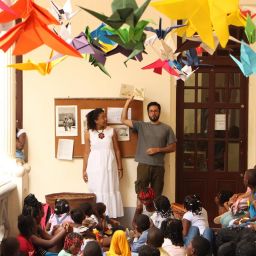
Some of the biggest political developments in the last decade in Latin America began with the work of investigative journalists. While media organizations in the region face commercial and other pressures, Latin American journalists and outlets continue to innovate and make a difference.
With this in mind, Tinker is supporting a new, multi-country effort to scale up solutions journalism in the region. The Solutions Journalism Network (SJN), which has championed this practice in the United States and elsewhere, defines it as “rigorous and compelling reporting about responses to social problems.” Solutions journalism investigates and explains, in a critical and clear-eyed way, examples of people working toward solutions to issues ranging from municipal lead pollution to funding for education. As an organization, SJN works to change the culture of news by training and connecting journalists, supporting newsrooms, and partnering with educators.
In Latin America, SJN is collaborating with the Fundación Gabo, the region’s preeminent journalism training organization, to bring solutions journalism to reporters and newsrooms across the region. During an initial two-year effort, the organizations will offer intensive training to a core group of journalists, who are committed to sharing their learning with colleagues in their home countries. The project also provides support for experimentation. In September, more than 100 journalists applied for funding to pursue solutions journalism projects; eight finalists were selected from Argentina, Brazil, Colombia, Guatemala, Mexico, and Venezuela. In addition, SJN and Fundación Gabo will select up to six leading newsrooms in the region to participate in “minilabs,” in which they will experiment with solutions journalism and produce at least two major articles each. Through these efforts, nearly 500 journalists will receive training in solutions journalism.
As an organization with deep links to media and audiences in the region, Fundación Gabo views solutions journalism as a way to combat apathy in the face of systemic challenges. Executive Director Jaime Abello notes, “Solutions Journalism is an unbeatable opportunity for Latin American journalists to enrich their mission and work by approaching reality from a narrative focused on assessing and investigating the responses to all those problems of which they have already gathered a clear diagnosis and shed a light on, but which are not approached from the perspective of what could contribute to improve them in order to empower audiences.”
For Tinker, investing in solutions journalism ties back to our larger commitment to democratic governance. When advocates and everyday citizens know potential solutions to social and environmental problems exist, they have greater capacity to demand accountability. In Cleveland, Ohio, traditional reporting on child lead exposure got little traction until the Plain Dealer newspaper looked at how peer cities had successfully addressed the problem; unable to excuse its lack of progress, the city overhauled its health leadership and approach. Across Latin America, solutions journalism is a way to bring attention to “what works” and hold leaders responsible for taking action.



